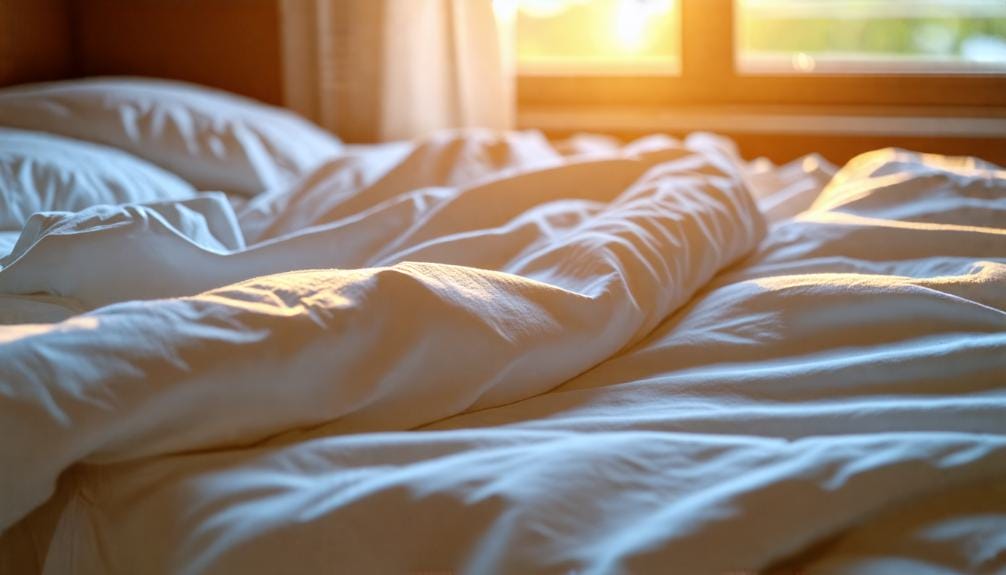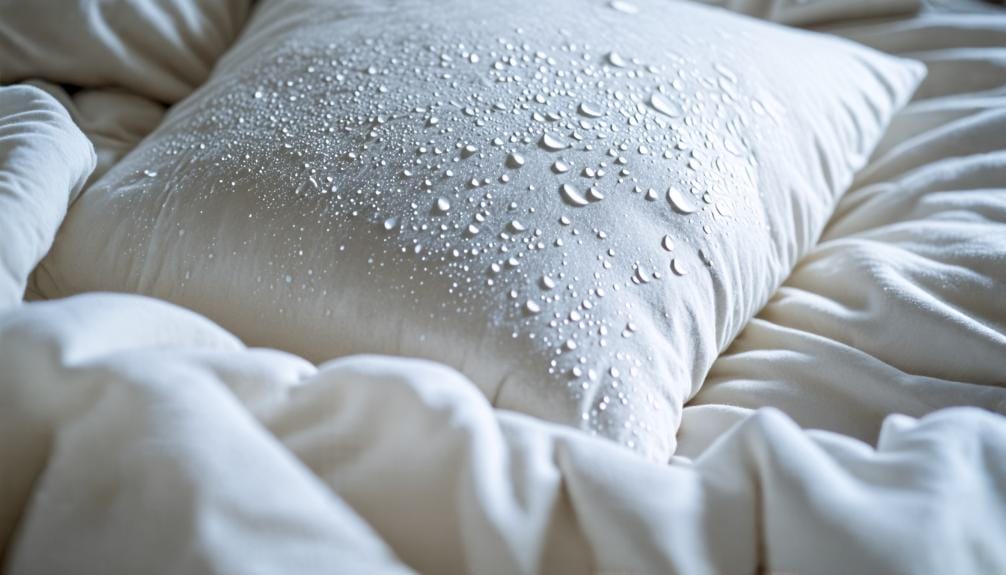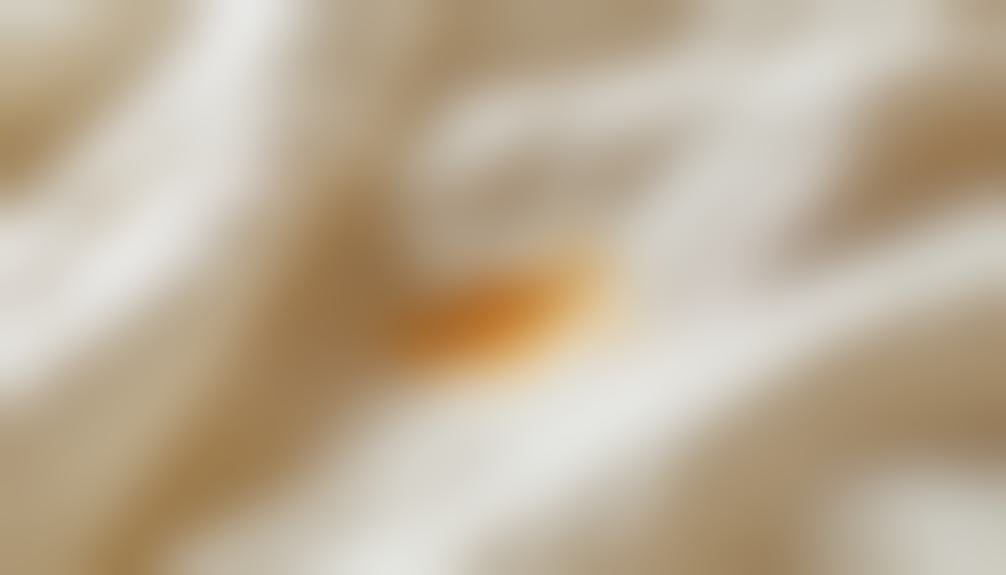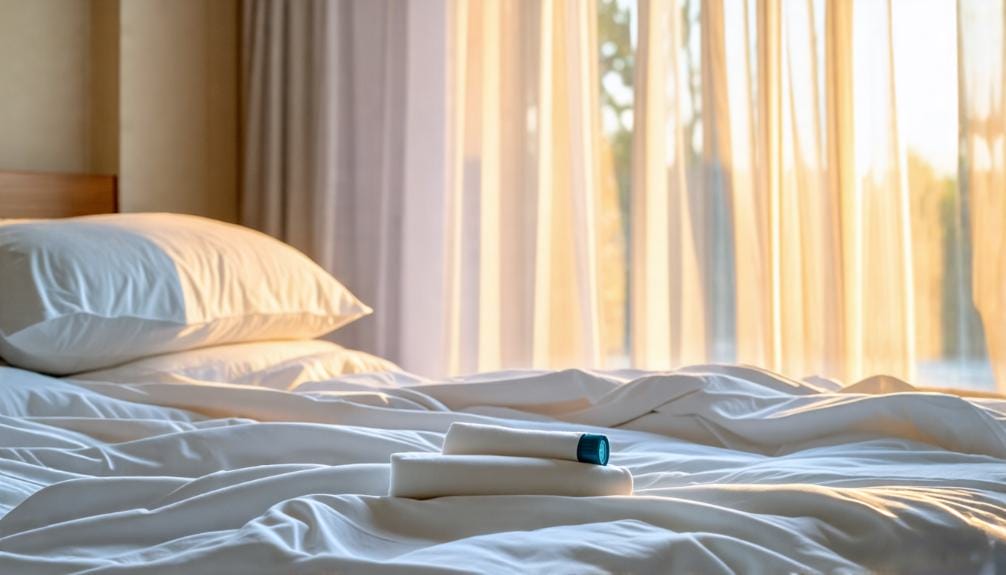Can Drool Stain Sheets? Find Out Now
You might not think about it, but drool can stain your sheets, and those marks can become quite noticeable over time. Whether you’re a deep sleeper or just enjoy a cozy nap, knowing how to handle these stains is essential for keeping your bedding fresh. It’s not just about appearance; the type of fabric and your diet can play a significant role in the severity of these stains. So, what can you do to prevent or remove them effectively? The answer might surprise you.
Can drool leave stains on bed sheets?

Drool can leave noticeable stains on bed sheets, which can be surprising to find in the morning. These stains not only detract from the appearance of your sheets but can also create lingering odors if not cleaned quickly. Saliva, produced during sleep, can penetrate the fabric, leading to marks that vary in color and texture based on what you’ve eaten and how well-hydrated you are.
The fabric of your sheets significantly affects how visible these stains are. While darker sheets may initially hide drool marks, they often become more pronounced as the saliva dries. To tackle these stains effectively, you might need to use a stain remover or a specialized cleaning solution to restore your sheets.
Addressing drool stains promptly is important to prevent odors from building up, which can negatively impact your sleeping environment. Accepting that drooling is a natural occurrence during sleep helps you take proactive measures, ensuring your bed sheets remain clean and fresh.
How to remove drool stains?
To remove drool stains from your sheets effectively, first, blot the stained area with a clean cloth to soak up any excess moisture. This step is crucial as it helps prevent the stain from setting deeper into the fabric.
After blotting, mix warm water with a few drops of mild detergent. Apply this solution directly to the stained area, gently rubbing it into the fabric with your fingers or a soft cloth.
Let the detergent sit for 5-10 minutes to help break down the stain. Once that time has passed, rinse the area thoroughly with cold water to eliminate any detergent residue.
If the stain is still visible, repeat the cleaning process or use a specialized fabric stain remover, following the product’s guidelines for optimal results.
After treating the stains, wash your sheets in the hottest water that’s safe for the fabric. Before putting them in the dryer, check the stained area.
If any drool stains remain, don’t dry the sheets, as heat can set the stain. Instead, repeat the stain removal process until the area is clean.
What causes drool stains?

Drool stains can be a nuisance, as they happen when saliva leaks from your mouth during sleep. This issue can stem from various factors including how deeply you’re sleeping, your sleeping position, and even the amount of saliva your body produces. Recognizing these causes is crucial for effectively addressing the problem.
| Factor | Description |
|---|---|
| Deep Sleep | In deep sleep, your body relaxes completely, making drooling more likely. |
| Sleeping Position | Lying on your side or stomach may lead to easier saliva escape. |
| Excess Saliva | Certain health conditions or medications can lead to increased saliva production, resulting in more drooling. |
| Food and Drink Choices | What you eat or drink before bed can impact saliva consistency and the likelihood of stains. |
To tackle drool stains, identify any patterns related to these triggers. If you notice recurring issues, consider adjusting your sleep habits or talking to a healthcare provider about potential health concerns. Keeping your bedding clean is vital, and using effective cleaning methods will help remove any stains. By pinpointing the reasons behind drooling, you can take steps to reduce its occurrence and ensure a more comfortable sleep environment.
Types of stains
Waking up to stains on your sheets can be frustrating.
It’s key to realize that different types of stains require different cleaning methods. For instance, saliva stains may differ from those caused by other liquids, and their color can change depending on what you’ve eaten or how hydrated you are.
Knowing these details will help you clean your sheets more effectively.
Saliva vs. other liquids
Saliva stains are distinct from stains caused by other liquids, each presenting unique challenges in terms of color and texture. Recognizing these differences is crucial for effective stain removal. Here’s a breakdown of saliva stains compared to other common liquid stains:
| Type of Stain | Characteristics |
|---|---|
| Saliva Stains | Often light; may dry to a white residue; discolored saliva can signal health issues. |
| Coffee Stains | Dark brown marks; difficult to remove without proper cleaning methods. |
| Red Wine Stains | Deep red and can become permanent if not treated quickly; requires prompt action. |
| Juice Stains | Color can vary (orange, purple); typically sticky and may attract insects. |
| Blood Stains | Dark red; cold water is essential for effective removal. |
If saliva stains are a common issue, consider your hydration levels and overall health. Good hydration and healthy bowel movements can help reduce excessive drooling, which in turn lessens the occurrence of these stains. Addressing these factors contributes to a cleaner and more pleasant sleeping environment.
Color variations
Color variations in drool stains can reveal important information about your health and lifestyle choices. Recognizing these hues is crucial, as they can signal underlying issues or habits that may need addressing. Understanding these distinctions allows you to take necessary action, whether that involves altering your diet or refining your cleaning methods.
Here are common drool stain colors and their potential meanings:
- Clear/White: Usually simply saliva, indicating normal drooling.
- Yellow: May signal dehydration or a diet rich in certain foods.
- Brown: Often associated with dietary habits, particularly from beverages like coffee or tea.
- Red: Could indicate blood, suggesting a health issue that warrants medical attention.
Recognizing these color variations helps you interpret drool stains and their implications for your well-being.
Different materials react differently to stains, making it vital to apply the correct cleaning methods to keep your bedding fresh.
Fabric considerations

Consider the fabric of your sheets carefully, as it impacts how visible drool stains can be.
Dark fabrics may mask stains initially, but they can become more noticeable over time.
Light fabrics, on the other hand, will reveal stains immediately.
Keep your comfort and cleaning preferences in mind as you make your decision.
Dark fabrics
Dark fabrics can initially disguise drool stains, making them less noticeable. However, as the moisture evaporates, these stains often become more visible against the rich colors. This can be frustrating, particularly if you want to keep your bedding looking clean. While dark sheets may seem appealing for hiding drool, knowing how to handle stains is essential.
Here are practical steps to tackle drool stains on dark fabrics:
- Act fast: Prompt treatment increases the likelihood of successfully removing stains.
- Use cold water: Rinse the stained area with cold water to stop the stain from setting.
- Select appropriate cleaning methods: Use a mild detergent that’s safe for the fabric type to avoid damage.
- Check for colorfastness: Before applying any cleaning solution, test it in an inconspicuous spot to make sure it won’t fade the color.
Light fabrics
Light fabrics are prone to drool stains, making it crucial to address them quickly to keep your bedding looking clean and fresh. Light-colored sheets can easily highlight any drool marks, leading to frustration in your efforts to maintain a pristine appearance. The more delicate the fabric, the more visible the stains become, especially if they dry and set into the material.
To effectively remove drool stains from light fabrics, follow these practical steps. First, blot the stained area with a clean cloth to soak up any excess moisture. Then, apply a gentle detergent diluted in water directly to the stain. Rinse the area thoroughly to eliminate any soap residue, and allow it to air dry.
Neglecting these stains can create health risks, as they may become breeding grounds for bacteria if not treated. Moreover, consistent drooling could indicate potential health issues, so it’s wise to consult a medical professional if you observe any unusual patterns.
Cleaning techniques
To remove drool stains from your sheets, use one of these effective cleaning methods: laundry detergent, a vinegar solution, or a baking soda paste.
Each option has its own benefits, so you can choose the one that suits you best.
Laundry detergent
Using the right laundry detergent is crucial for effectively removing drool stains from your sheets. To tackle these stains, you need a detergent that can break down proteins and lift the stain from the fabric.
Here are practical tips for selecting the most effective laundry detergent:
- Opt for enzyme-based detergents, as they excel at breaking down organic stains like drool.
- A pre-treatment spray can be useful for targeting the stain before washing, improving stain removal.
- Always verify that the detergent is suitable for your specific fabric type to prevent any damage during washing.
- For tough stains, adding a cup of white vinegar to the wash cycle can provide extra cleaning power.
While professional cleaning services can assist with tough stains, many can be effectively managed at home.
The right laundry detergent paired with these techniques will help keep your sheets looking fresh and clean, contributing to a more comfortable sleep environment.
Don’t let drool stains disrupt your nights—take proactive steps with the right products!
Vinegar solution
A vinegar solution is a practical method for removing stubborn drool stains from your sheets while also neutralizing odors. White vinegar is effective at lifting stains and leaving your bedding smelling fresh. To make this cleaning mixture, combine equal parts of vinegar and water in a spray bottle.
Before applying the solution to the stained area, it’s important to test it on a small, hidden section of the fabric to confirm that it won’t cause any discoloration. Spray the mixture directly onto the drool stain and allow it to sit for approximately 15 minutes. After that, blot the area with a clean cloth and wash the sheets as you normally would.
Here’s a quick reference table that outlines the advantages of using vinegar for cleaning:
| Benefits | Details | Usage Tips |
|---|---|---|
| Stain Removal | Effectively lifts stubborn drool stains | Apply directly to stains |
| Odor Neutralization | Eliminates unpleasant smells | Let sit before rinsing |
| Fabric Safety | Generally safe for most fabrics | Always test on a small area |
Try this vinegar solution for your cleaning needs and experience its effectiveness firsthand!
Baking soda paste
Baking soda paste is an effective solution for removing drool stains from fabric. It works as a gentle abrasive, lifting residue while also neutralizing odors, which refreshes your sheets.
Here’s a straightforward method to create and apply a baking soda paste for drool stains:
- Combine 1/4 cup of baking soda with a few tablespoons of water to create a thick paste.
- Spread the paste evenly over the drool stains, ensuring complete coverage.
- Allow it to sit for 30 minutes so the baking soda can penetrate the fabric and break down the stains.
- Scrub gently with a soft brush or cloth to remove the residue.
- Rinse with cold water and launder your sheets as you normally would.
Using baking soda for stain removal is a practical method that not only addresses tough stains but also eliminates any unpleasant odors caused by drool.
Try this technique to restore the freshness of your sheets!
Professional cleaning options

If home remedies aren’t working for those tough drool stains, consider professional cleaning options.
Dry-cleaning solvents can effectively remove stubborn stains, and stain removal services have specialized techniques to restore your sheets.
Exploring these choices can save you time and ensure your bedding looks fresh and clean again.
Dry-cleaning solvent
If you’re dealing with drool stains on your sheets, a dry-cleaning solvent can be a practical solution. This method effectively removes tough stains while preserving the fabric quality.
Here’s a straightforward process to follow:
- Pre-treatment: Apply the dry-cleaning solvent directly onto the drool stains, allowing it to soak into the fabric.
- Gentle agitation: Use a soft brush or cloth to work the solvent into the fibers, helping to lift the stain.
- Rinse thoroughly: Rinse the area well to remove any leftover solvent, which is important for your health and safety.
- Regular care: Use fabric softener in your next laundry cycle to keep the sheets feeling fresh and soft.
Using dry-cleaning solvent can significantly improve the appearance of your sheets by effectively addressing drool stains. This approach protects your bedding while ensuring a clean and comfortable sleeping environment.
Don’t let minor stains disrupt your rest—take action and enjoy a cleaner space!
Stain removal services
Using a dry-cleaning solvent can help remove drool stains at home, but many people prefer professional cleaning services for guaranteed results. These experts are skilled in handling a variety of fabrics and can effectively treat drool stains that home remedies may not fully remove.
Investing in professional cleaning not only ensures your bedding is clean but also hygienic. Professionals are knowledgeable about the right cleaning methods for different fabric types, which helps preserve the sheets’ quality while effectively tackling stains. They can also address any lingering odors associated with drool stains, providing a comprehensive solution.
Professional cleaners have access to advanced equipment and specialized cleaning agents that are typically unavailable for home use. This means they can tackle tough stains without risking damage to your sheets. For persistent drool stains and a fresh sleeping environment, consider contacting specialized stain removal services.
Your sheets—and your sleep quality—will greatly benefit from their expertise.
Health implications
Excessive drooling can indicate health issues that need attention.
Allergies, sensitivities, or certain medications may cause this condition.
Identifying the cause is crucial for effective treatment.
Addressing these issues can lead to better sleep and improved overall health.
Excessive drooling causes
Excessive drooling can arise from a variety of health concerns, including allergies, side effects from medications, or neurological disorders. Identifying the underlying causes is crucial for your overall health.
Here are some key factors that can lead to excessive drooling:
- Hydration levels: Dehydration may thicken saliva, resulting in increased drooling.
- Diet: Foods that are spicy or acidic can stimulate higher saliva production.
- Medical conditions: Issues like gastroesophageal reflux disease (GERD) may contribute to excessive drooling.
- Medications: Certain medications, especially those affecting the nervous system, can lead to increased saliva output.
Recognizing these factors is important for addressing the root causes of excessive drooling.
If you experience persistent drooling that disrupts your daily life or sleep, consult a healthcare professional. They can provide specific advice and potential solutions to help with this issue.
Allergies and sensitivities
Allergies and sensitivities often lead to increased drooling, particularly during sleep, as your body responds to environmental irritants. If you’ve noticed drool stains on your sheets, consider whether allergens such as dust mites, pollen, or pet dander might be affecting you. These irritants can trigger excessive saliva production, resulting in drooling that leaves marks on your bedding.
Sweat stains can also complicate the situation, making it harder to keep your linens clean. To address these problems, effective cleaning practices are essential. Wash your sheets regularly in hot water to eliminate allergens and remove drool stains. Using hypoallergenic laundry detergents can help prevent skin reactions and reduce sensitivities.
If drooling continues, it may signal an underlying health concern related to your allergies. Consulting with a healthcare professional can provide insight and assist in managing both your allergic reactions and drooling.
Frequently Asked Questions
Can Drooling Be a Sign of a Medical Condition?
Drooling can indeed signal a medical condition. If you notice excessive drooling, it might be worth consulting a healthcare professional. Factors like medication side effects or neurological issues could be at play, so don’t hesitate to seek advice.
How Can I Prevent Drooling While Sleeping?
To prevent drooling while sleeping, try sleeping on your back, keeping your head elevated, and staying hydrated. Additionally, consider addressing allergies or sinus issues, as they can contribute to excessive drooling during sleep.
Do Certain Foods Increase Drooling During Sleep?
Certain foods, especially spicy or acidic ones, can increase saliva production, leading to more drooling during sleep. If you notice excessive drooling, consider adjusting your diet to see if it helps reduce the issue.
Is Drooling Common in Children and Adults?
Drooling’s common in both children and adults, often due to sleep position or relaxation. It’s usually harmless, but if you notice excessive drooling, it might be worth discussing with a healthcare professional.
Can Nighttime Posture Affect Drooling Levels?
Yes, your nighttime posture can influence drooling levels. If you sleep on your side or stomach, gravity may cause more saliva to escape. Adjusting your position might help reduce excessive drooling during sleep.
In Conclusion
In summary, drool can definitely stain your sheets if left untreated, so it’s vital to act quickly.
By comprehending what causes these stains and knowing the right cleaning techniques, you can keep your bedding fresh and free of odors.
Whether you choose to tackle it yourself or seek professional help, maintaining clean sheets will improve your sleep environment.
Don’t underestimate the importance of a little proactive care for your bedding!
